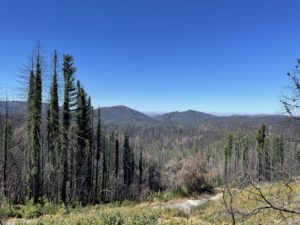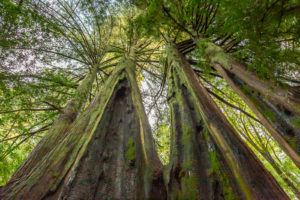Imagine a landmark so prominent that anyone looking south from San Francisco or north from San Jose could spot it. Spanish missionary Padre Pedro Font wrote in his diary in March 1776: “I beheld in the distance a tree of immense stature rising above the plain of oaks like a grand tower.” The colossus was El Palo Alto (Spanish for “tall tree”), a three-trunked redwood tree — one trunk of which still stands at the boundary of the cities of Palo Alto and Menlo Park on San Francisquito Creek. The 1,100-year-old tree is short by redwood standards — the Spaniards measured it at 137 feet in its glory days — but on a flat plain with few other redwoods around, it was a giant. Since 1988, local resident Jim Johnson has spearheaded an effort to save Palo Alto’s namesake Tall Tree from an early death. Johnson is now Streamkeeper for the San Francisquito Creek Watershed Council, a project of Acterra (www.acterra.org).
JJ: Originally El Palo Alto had three trunks. We have pictures from the 1800s showing two trunks; the third trunk is an ax-scarred stump attached to the remaining single trunk — no one knows what happened to it. In the late 1880s storm waters weakened the second trunk, which was the closest to the creek, and it fell. After that, Leland Stanford, who owned the area then, built a bulkhead out of railroad ties to protect the remaining trunk. Later, the creek once again threatened to undermine the tree, so the Southern Pacific Railroad (whose tracks ran alongside the tree) and Stanford University (which owned the land) jointly built the present wall. Today, an additional dam at the base of the wall prevents the streambed from degrading further.
Q: When and why did you take up the cause of preserving El Palo Alto?
JJ: When I first moved down here from the North Coast in 1971, I used to walk along San Francisquito Creek near El Palo Alto. It’s a canyon, 25 to 30 feet deep, on an alluvial fan. It’s a little oasis in the middle of the city. You don’t see houses or hear cars. I used to draw, bird-watch, and meditate down there. I first became aware that the tree was in trouble in January of 1988 after a big, windy storm. I was walking along the creek and it looked to me like the tree was leaning more than normal, and neighbors confirmed that. I called the Palo Alto city arborists and left a message. No one returned my call. They didn’t seem to be too concerned. I was. I thought the tree might fall.
I felt I had a spiritual connection to the creek; it was a place of refuge. So I began to work on the tree’s behalf. At that time, that area of the creek was a homeless encampment for 25 or 30 people, and the rest of the population didn’t go there anymore. I took pictures of the tree and its problems and also of the homeless encampment beneath it. I made a poster from the pictures and started Friends of El Palo Alto. I went to the co-op grocery store and got a hundred signatures from people, and took that petition the next night to the city council. I made a plea on behalf of the tree and asked them to have the city arborists begin to take care of it. And they did. First, they established a watering and fertilizing schedule. A sprinkler head at the top of the tree with a pipe going up to it had been installed in 1955 and was supposed to simulate coastal conditions by fogging the tree at night. But the water pressure wasn’t sufficient to get water up to the top of the tree, so a booster pump was installed.
Q: Why would a tree that existed for 1,000 years need that kind of help?
JJ: Because urban growth had caused the water table to drop. I’ve since discovered that other redwood trees planted along the banks of the creek have taproots, roots that go straight down, whereas most redwoods have roots that spread out. A redwood just upstream from El Palo Alto is probably 100 years old and its taproot goes straight down into the soil 15 feet or so and then has large roots coming out into the soil. That’s how El Palo Alto was able to survive so far out on this dry plain all those centuries. It was a thin tree, sparse, not thickly clothed, and it didn’t grow very tall because of the limitations of water.
When Palo Alto, Menlo Park, Atherton, and all the surrounding cities came along, they took their water from groundwater wells. As the cities grew, as Stanford University grew, so much water was being taken from the San Francisquito Creek system that the water table dropped and the wells started to go dry. By the 1960s, so much salt water was intruding into the wells near the Bay that the cities finally decided to switch to getting their water from the Hetch Hetchy system. The wells and groundwater started to recover after that. During the period when the water table sank, El Palo Alto was unable to get its usual supply of water, so it was just gradually dying. By the mid-1960s it was really in decline, and by the 1980s it looked terrible. The city started to cut sections off the top of the tree as it died back and by 1988, it was down to about 112 feet.
At that point, the tree still had not reconnected with the water table, but when the arborists started to water and fertilize it, it responded quickly. New growth occurred at the top — a shoot came from the flat apex of the tree. In a few years that new sprout became a little bush. Now it’s about ten feet tall. The whole tree began to fill out. It had been just a stick before. To me, that was a great success — in just a few years we had brought this tree back. The watering the city provided at the tree’s roots also enabled us to restore a forest ecosystem there. We’re re-establishing native vegetation in nine different sites in the watershed from seeds that we gather up in the hills and raise in our native plant nursery in Palo Alto Park. We maintain these sites carefully because if we don’t, the Himalayan blackberry and the cape ivy will come back in and overwhelm them.
Q: How did your concern for El Palo Alto develop into your work for San Francisquito Creek?
JJ: We began with the tree, getting it healthy again. In March of 1988, two months after I noticed the lean of the tree, I found two dead steelhead in the creek. I hadn’t known it was a steelhead stream. These fish were 27 to 30 inches long. That was a dry year, but they shouldn’t have died, particularly steelhead, because, unlike salmon, they can spawn many times. If they don’t spawn for some reason, they just turn around, go back to the ocean, and come back the next year to try again. I think the pollution from rat poison used at the homeless people’s encampments contributed to their deaths.
The encampments had made the bushes into a big toilet. In 1988 a local nonprofit, the Urban Ministry, was saying to the city, “You have to let people live in the creek. Where else can they go?” They actively defended the encampments. Every time we brought up the fact that there were a lot of ecological consequences, the city would say, “Well, the Urban Ministry thinks we shouldn’t evict people.”
But when a drug and alcohol counselor became the director of Urban Ministry, he said to the city council, “You’re acting as codependents for these people. They’re drug and alcohol addicts. They’re not getting better. They shouldn’t be living there, and the creek is a mess.” Many of the people living in the creek were Vietnam veterans and a local VA hospital had just opened a shelter for homeless vets. So now they had a place to go. The city said, “All right, we won’t allow camping in the creek anymore.” Since then there’s been much less trash in the creek.
One of our goals is to rehabilitate these streams for a host of native species — including steelhead — by improving habitat conditions and reconnecting the upstream spawning areas to the ocean. We negotiated with Stanford and eventually, in 1995, they installed a fish ladder at the Felt Lake Diversion Dam to provide access for steelhead to another two miles of really good rearing habitat. The best water in the whole watershed is up there, coming from some big springs in the earthquake-fractured serpentine formation. Now fish can get into the headwaters again.
Q: What keeps you doing this work after all these years?
JJ: It really feels like I’ve undertaken a spiritual mission. The mosaic on the facade of the Stanford Memorial Church was blown off during the 1906 quake and later thrown into the creek. One spring I found a flat alabaster piece in the creek. I turned it over and there was a “w” inscribed on it. And so I saved it. The next year in a different part of the creek, maybe a mile and a half away, I saw another piece of alabaster. I turned it over and there was an “ith” on it. I got home and I put them together and they fit and formed “with.” It symbolizes how I feel about the tree and the creek.
Q: Do you expect El Palo Alto to outlive you?
JJ: Yep, I sure do.




